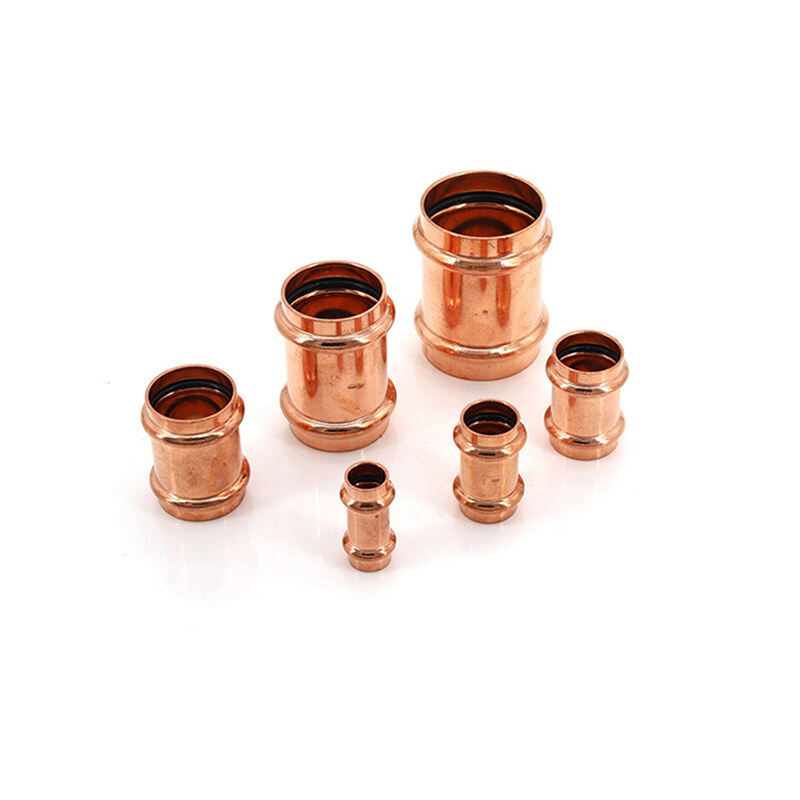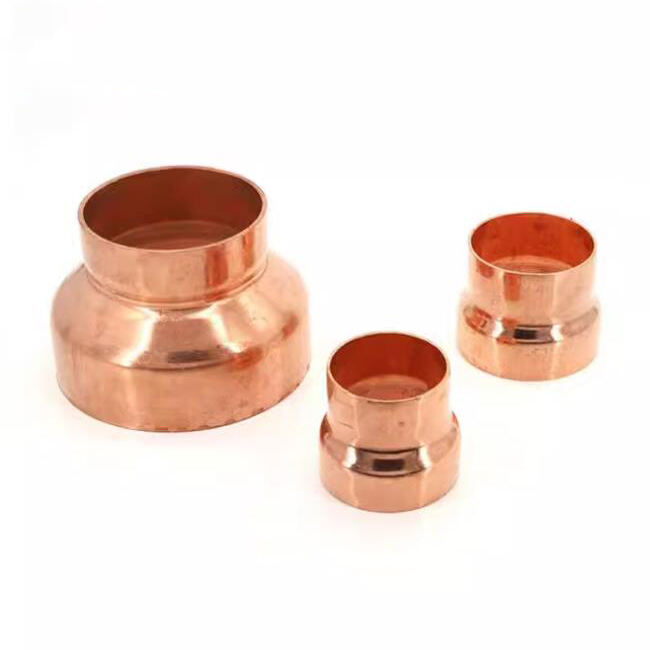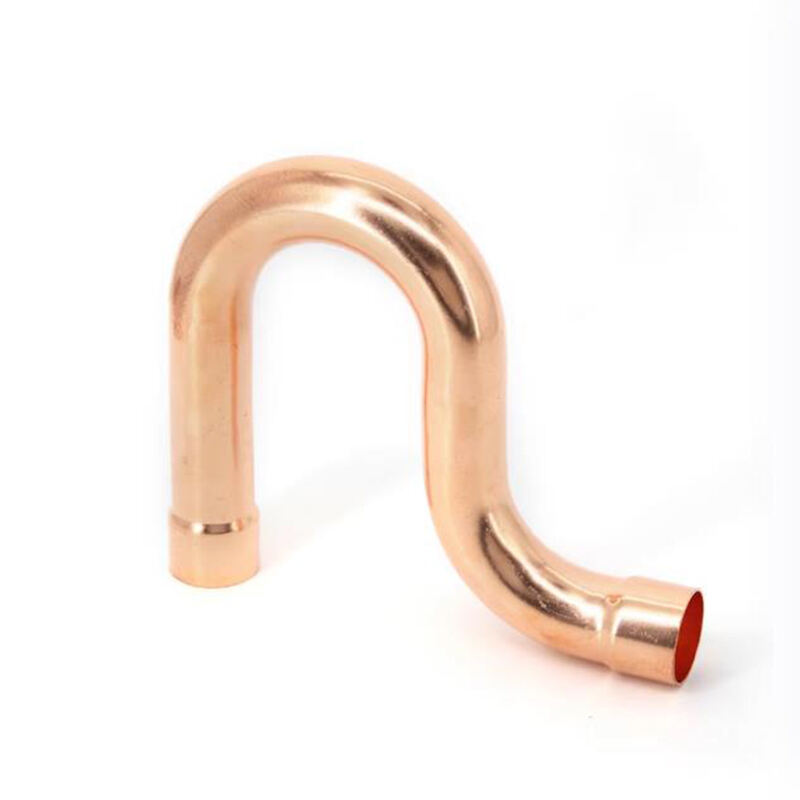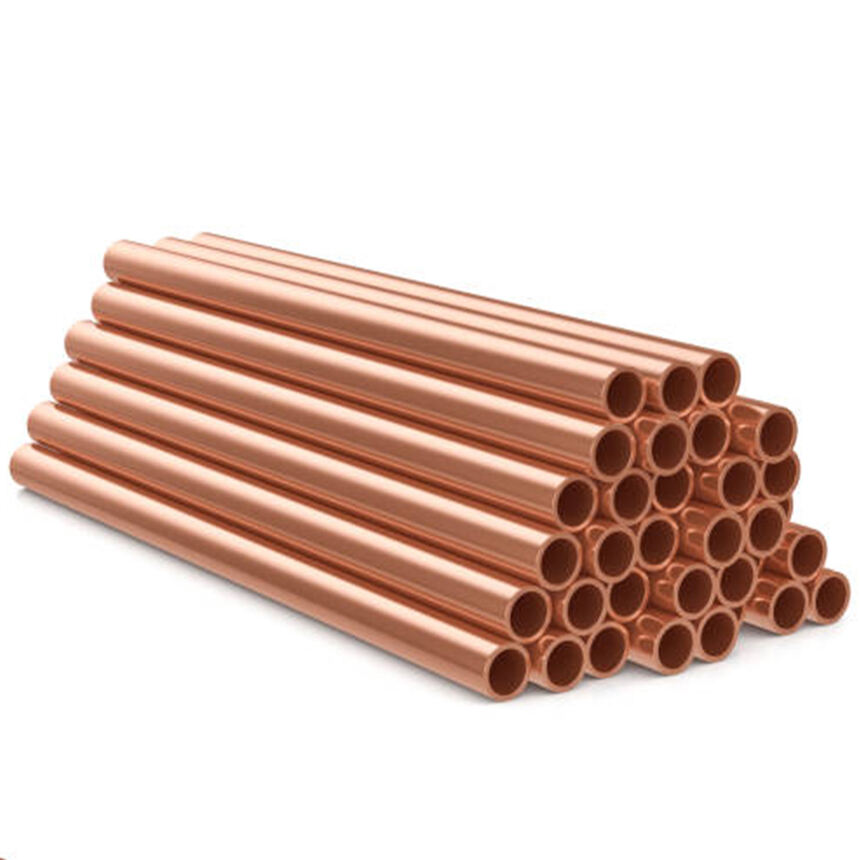Understanding Copper Tee Fittings in Pipe Networks
What Are Copper Tee Fittings?
Copper tee fittings, sometimes called Copper Tees, play a really important role in plumbing and HVAC systems where they help split or combine pipes. Shaped like the letter T, these fittings connect three pieces of copper pipe together so fluids can change direction or branch off without issues. Copper itself has been used in plumbing for ages because it lasts long and doesn't rust easily. The ancient Egyptians actually started using copper pipes way back when for their water systems. Over time, copper fittings became standard in all sorts of pipe work. Today, plumbers rely on them extensively whether installing new bathroom fixtures at home or setting up complex industrial cooling systems across factories.
Structural Design and Material Composition
What makes copper tee fittings so reliable comes down to their physical properties. Copper can bend without breaking and holds up under pressure pretty well too. That's why plumbers trust copper for these connections. Most copper tees are made from what's called high grade copper metal. This material meets certain quality benchmarks so it works across different types of piping systems. When installing copper tees, technicians often pick between different copper grades based on what the job requires. Some grades stand up better against corrosion or temperature changes than others. This means copper fittings last longer and perform consistently whether they're inside walls or exposed to harsh outdoor conditions.
Types of Copper Tees: Compression vs. Soldered
When it comes to copper tees, there are basically two main options out there: compression fittings and soldered ones, both with their own pros and cons. Compression fittings work by squeezing a metal ring (called a ferrule) around the pipe to make a tight seal. What makes these so handy is that they don't need any heat during installation, which is great for those last minute repairs or when working with different pipe materials like copper, plastic, or even steel. The other option requires actual heating to fuse the pieces together, creating what most plumbers would call a rock solid connection that won't leak. These soldered joints have been the go-to choice for decades in situations where pressure matters a lot or when someone wants something that will stay put forever. Most folks pick between these two based on what kind of job they're tackling and what sort of pipes they happen to be dealing with at the time.
Key Properties and Advantages of Copper Tees
Durability and Corrosion Resistance
Copper tees are really tough stuff when it comes to lasting through all sorts of conditions. They resist rust and corrosion better than most metals, so they keep working properly even after many years. Some tests indicate these fittings might actually hold up for around 70 years in regular use situations, way longer than steel or plastic parts that tend to need replacing every few years at best. Plumbers know this well because copper doesn't crack or degrade easily in hot water lines or cold basement installations. That's why so many professionals still reach for copper when installing new pipes or fixing old ones, especially in areas where moisture is always present.
Thermal Conductivity for HVAC Efficiency
Copper has this amazing property where it conducts heat really well, which makes a big difference in how efficient HVAC systems actually run. When copper transfers heat so effectively, it basically boosts the whole performance of both heating and cooling systems because the heat moves around much better during those exchange processes. A lot of people who work in the field will tell you that going with copper piping for installation jobs means temperatures stabilize faster, which cuts down on wasted energy and saves money on bills over time. That's probably why we see copper pipes showing up everywhere from commercial buildings to residential setups whenever there's a need for top notch thermal performance. Some plumbers even swear by copper specifically for certain tricky installations where other materials just don't cut it.
Antimicrobial Benefits for Water Safety
Copper fittings actually kill germs on contact, which helps keep water systems much safer than other materials. Copper naturally stops bad bacteria from growing on its surface because it releases ions that destroy microorganisms. Health groups around the world have done tests showing copper works really well against stuff like Legionella and E. coli in plumbing systems. It also fights off those slimy biofilms that can build up inside pipes over time. For homes and businesses alike, switching to copper piping means cleaner water coming out of taps everywhere. Plumbers often recommend copper specifically for hospitals and schools where water quality matters most to protect people's health.
Applications of Copper Tees in Modern Systems
Residential Plumbing Networks
Copper tees are really important parts of any home's plumbing system, helping water get where it needs to go both into and out of the house. When installed properly, these fittings make sure every corner of the house gets its share of water supply whether it's the bathroom sink, kitchen faucet, or even the washing machine in the laundry room. Most homes will have at least one copper tee somewhere near the main water line branching off to different fixtures around the house. What makes them so good is how they let water flow through without losing much pressure along the way, which is why plumbers often recommend them for standard residential setups. Made from durable copper material, these fittings tend to last decades with hardly any issues, saving homeowners money on repairs down the road since they don't need replacing as frequently as other types of piping connections.
Industrial Cooling and Heating Systems
When it comes to big industrial setups, copper tees really stand out because they work so well for both cooling and heating needs. Copper conducts heat pretty darn well, which means it handles those temperature changes that happen all the time in factories and plants. If we look at other materials used for similar purposes, copper fittings just tend to last longer and need less fixing over time. That translates into better running operations across the board while using less power overall. What makes copper特别 good is how tough it actually is. These systems keep performing even when things get rough in industrial settings where equipment faces constant stress day after day.
Medical Gas Line Configurations
Copper tees play a vital role in medical gas line setups because they offer both safety advantages and efficient performance. The metal naturally resists microbial growth and doesn't develop leaks over time, so when doctors need oxygen or other gases delivered during procedures, patients stay protected from contaminants. Most hospitals follow strict rules set by agencies like OSHA and NFPA that recommend copper specifically for this reason. Without proper materials, something as simple as a small leak could mean wasted resources or worse, compromised patient care situations where every second counts.
Installation Best Practices for Copper Tees
Soldering Techniques for Leak-Free Joints
Getting those copper pipe connections completely sealed against leaks depends heavily on proper soldering methods. Most plumbers will tell anyone who asks that cleaning the pipe ends and fittings really well comes first. Any old oxide layers or grime left behind just messes up the bond between metal pieces. After everything's spotless, smear some good quality flux onto both parts so the molten solder flows smoothly when applied. A lot of folks mess this up by either heating the copper too much, which actually makes the fittings weaker over time, or not putting enough solder on at all. The result? Weak spots where water finds its way through eventually. Finding that sweet spot with solder quantity matters a ton for making solid joints without going overboard and wasting material.
Using Compression Fittings for Easy Maintenance
Compression fittings bring some real benefits when installing copper tees, especially around maintenance work. What makes these fittings so good is their ability to snap together quickly and come apart just as fast. That's why plumbers love them for setups where regular checks or updates are needed. Soldered connections tell a different story altogether. Once those joints are made, changing anything becomes a pain in the neck. Trying to fix a leak means cutting out sections and starting over from scratch. With compression fittings though, technicians can make adjustments right there on site without having to tear everything down. Systems stay stable while still being accessible for service work whenever necessary.
Pressure Testing and Quality Assurance
After installing copper tees, running pressure tests becomes really important for checking if everything holds together properly and spotting any weak spots before they become problems. These tests can catch all sorts of issues including leaks at connections, failed joints, or even flaws in the materials themselves that might cause headaches down the road. Most plumbers follow standard procedures when doing these tests, keeping pressures within what local codes allow while watching closely with proper monitoring gear to see how things react under stress. Groups like ASTM set out good rules for how to perform these checks effectively. Following their recommendations helps ensure those copper fittings will last years instead of just months, which saves money and prevents water damage in buildings.
Copper Tees vs. Alternative Materials
Longevity Compared to Plastic Fittings
Copper tees last way longer than plastic ones because they just don't break down as easily. The metal stands up to corrosion and all sorts of wear and tear, so these fittings keep working properly for years on end. That's why plumbers tend to reach for copper when installing systems that need to handle tough conditions day after day. We've seen this play out in real world situations too. Copper pipes stay strong even when exposed to harsh chemicals or extreme temperatures something plastic simply cannot handle without eventually cracking or warping. For anyone concerned about getting reliable plumbing that won't need constant repairs, copper tees are definitely worth considering especially important stuff like hot water lines, HVAC systems, and anything connected to drinking water supply.
Cost-Effectiveness Over Stainless Steel
Looking at copper versus stainless steel fittings, copper usually comes out ahead when budget matters. The upfront price tag for copper is typically cheaper than stainless steel, plus it lasts longer without needing repairs or replacements because it holds up better over time. Someone who works at 22/7 Enterprise mentioned recently that stainless steel can handle those really high pressure scenarios, but for everyday installations where pressure isn't extreme, copper offers good value for money without sacrificing quality. When picking between these materials, plumbers need to think about what the job actually requires. If there's going to be constant water hammer issues or exposure to corrosive substances, then maybe stainless steel is worth the extra spend. But for most residential and commercial projects, copper just makes more sense financially in the long run.
Environmental Impact and Recyclability
When it comes to green building materials, copper fittings really shine because they can be recycled over and over again without any loss in quality. That means copper products don't end up taking space in landfills after their useful life is done. Plastic alternatives tell a different story altogether. Most plastics either can't be recycled at all or require complex processes that aren't always effective. Studies from the copper industry show something interesting too copper recycling actually takes about 85% less energy than making brand new copper from raw ore. The reduced energy consumption translates into fewer carbon emissions overall. For companies working on eco friendly construction projects, switching to copper makes good business sense as well as environmental sense. Many architects and contractors are starting to specify copper components specifically because clients want buildings that have smaller environmental footprints these days.









